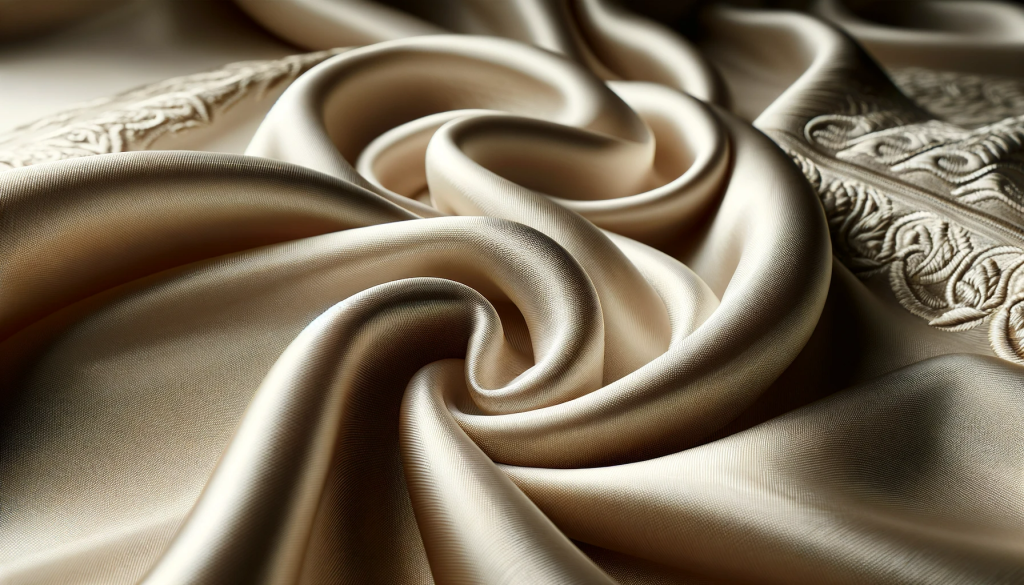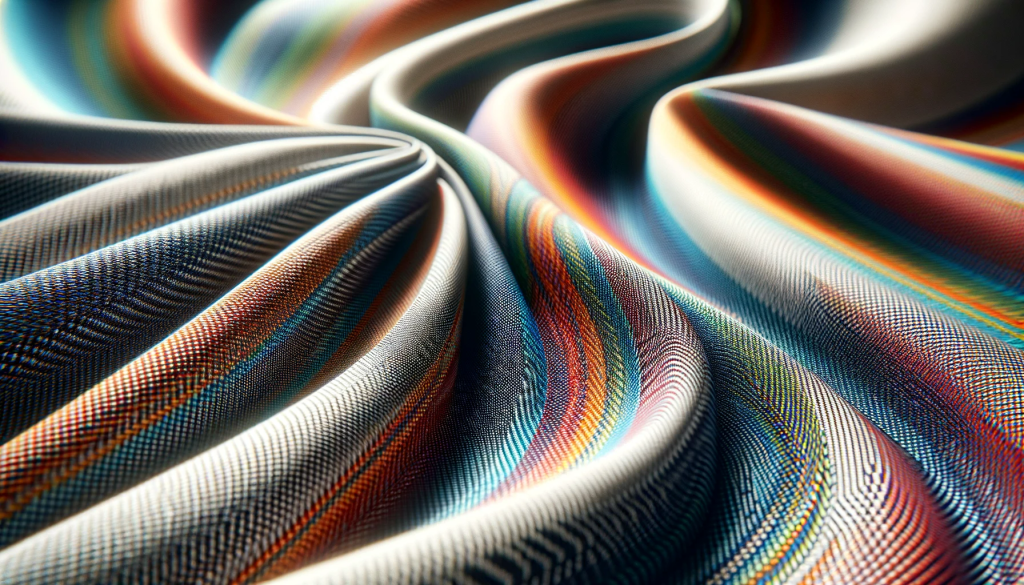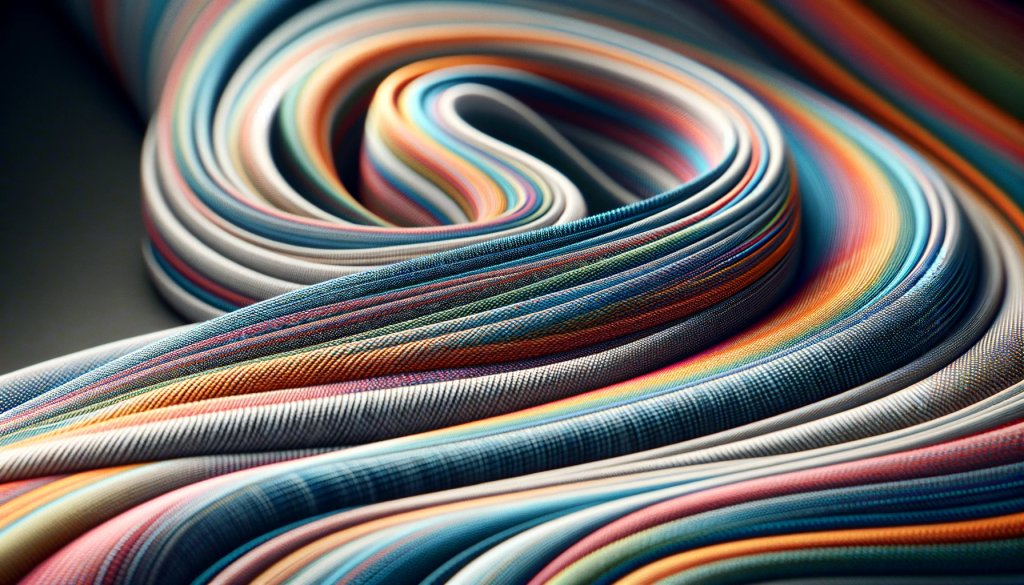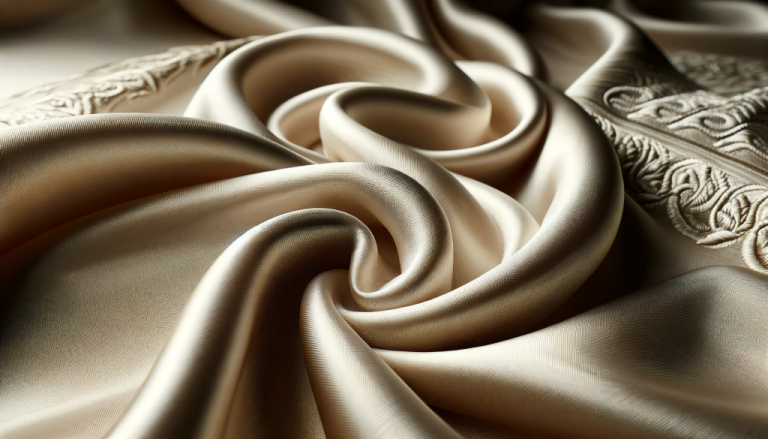Discover the delicate charm of rayon fabric, a semi-synthetic marvel celebrated for its silk-like softness and versatility in fashion. With the right care techniques, your rayon garments can maintain their allure and longevity. For chic and stylish rayon clothing, explore InktasticMerch and elevate your wardrobe with ease.
Have you ever eagerly taken your favorite shirt out of the dryer, only to discover it has shrunk? Rayon is a widely cherished fabric, celebrated for its silky texture and elegant flow. This article will serve as your guide to understanding rayon fabric and mastering the art of cleaning and caring for it, ensuring your garments remain captivating.
Continue reading to become an expert in rayon care!
Key Takeaways
- Rayon, a semi-synthetic fabric crafted from cellulose fibers, mimics the softness of silk and comes in various forms like viscose, modal, lyocell, and bamboo rayon.
- To properly care for rayon, wash it in cold water using a gentle cycle or by hand, gently handling the fabric without twisting; dry it flat away from direct heat; and iron it at low temperatures with a pressing cloth.
- Concerns about the environmental impact of rayon production exist due to the harmful chemicals used, yet sustainability can be improved with responsible manufacturing and mindful consumer choices.
- Rayon is less robust compared to some other fabrics and can shrink or fade if not properly looked after; attentive care is necessary to preserve its appearance over time.
- Alternative sustainable options to traditional rayon include organic cotton, hemp, linen, Tencel™️ (lyocell), recycled polyester, and responsibly sourced wool, offering varying sustainability benefits.
What is Rayon Fabric?

Rayon fabric is a multifaceted textile that feels like silk, prized for its cost-effectiveness and versatility in both fashion and interior design. It’s semi-synthetic, made from renewed cellulose, and merges the qualities of natural and artificial fibers to provide comfort and adaptability in a wide range of apparel.
Definition of Rayon
Rayon is a smooth, adaptable fabric frequently used in apparel and home textiles. It’s derived from regenerated cellulose fibers, originating from wood pulp or cotton by-products, offering a sleek texture akin to natural materials like silk or cotton.
Though it starts from plant-based sources, rayon is categorized as a synthetic fabric due to the chemical processes involved in its production.
Manufacturers are fond of rayon for its capability to retain vibrant hues and its elegant drape, making it a favored choice for clothing ranging from tops and dresses to bed linens and drapes. This material is valued in the textile sector for its opulent appearance without the hefty price tag of some organic fabrics.
Rayon offers breathability similar to cotton and has excellent absorbency, adding to its comfort in various climates.
How Rayon is Made
The journey of rayon commences with its natural origins. Manufacturers create this multi-use fabric by chemically altering cellulose, which is typically procured from wood pulp from trees like beech, pine, and eucalyptus.
The manufacturing process initiates with collecting suitable wood and isolating pure cellulose through a sequence of operations that include shredding the wood and dissolving it in chemicals. This leads to the formation of a thick fluid known as ‘viscose’ in the textile world, which is then extruded into fibers.
The transformation advances as these viscous strands are pushed through a spinneret, similar to a showerhead changing liquid into slender threads. Once out, the fibers solidify upon air contact and are treated with sulfuric acid, resulting in semi-synthetic strands ready for weaving or knitting.
The subsequent step involves cleansing and refining these threads to enhance their comfort when worn. Afterward, the fabric continues its journey to ensure a comfortable finish against the skin. After
Through meticulous cleaning and drying procedures, we produce threads that are soft yet robust, mirroring the qualities of silk or cotton: welcome to rayon—a marvel not only in its diverse applications but also in its creative fabrication!
Distinct Varieties of Rayon Fabrics
Diving into the myriad of rayon fabrics unveils a spectrum of textiles, each boasting its own unique attributes and purposes. Let’s explore the various types that you may come across.
- Viscose Rayon: Known as the most prevalent type, viscose emulates the silkiness with its soft, smooth finish. Its breathability and high absorbency make it a popular choice for summer clothing.
- Modal Rayon: Celebrated for its increased strength when damp, modal resists shrinkage and fading, maintaining shape and color admirably—a perfect choice for garments subject to frequent washing.
- Lyocell: Marketed under the brand Tencel, lyocell is distinguished by its eco-friendly production process. It features high durability and excellent moisture management, making it ideal for activewear.
- Cuprammonium Rayon: Often termed cupro, this rayon is finer and lighter than other variants. Its silky texture is ideal for opulent lingerie and the lining of premium garments.
- Bamboo Rayon: Crafted from bamboo pulp, this type combines environmental consciousness with smoothness. Its natural antibacterial and hypoallergenic properties make it suitable for sensitive skin or allergy-prone individuals.
How is Rayon Fabric Created?

Unpacking the creation of rayon fabric uncovers a captivating process that converts natural cellulose into exquisite, adaptable textiles. By exploring this transformation from raw material to finished product, we illuminate the complexity and artistry of one of fashion’s cherished fibers.
Materials and Process
The creation of rayon fabric begins with cellulose, typically sourced from wood pulp or cotton. Manufacturers solubilize the cellulose in chemicals such as caustic soda and carbon disulfide to form a dense liquid known as viscose.
This viscous mixture is then extruded through fine spinneret holes, solidifying into filaments upon contact with air. These threads are drawn out and spun into yarns.
The resulting yarns are woven or knitted to produce soft, adaptable rayon fabrics, widely used in the textile industry. Thanks to their high absorbency, these textiles can be dyed in vibrant hues more effectively than other synthetic materials.
Rayon captures the luxurious feel of silk while being significantly more affordable than most natural fibers. However, it requires special care during washing, as it can shrink if mishandled—gentle machine washing and minimal use of fabric softeners are recommended.
Environmental Considerations
The production of rayon fabric raises several environmental issues. The chemicals used to transform plant pulp into delicate threads can pose ecological risks if not properly managed. Factories might emit toxic substances into the environment, endangering both wildlife and human health.
In regions with limited regulations, this waste can be a major concern.
As consumers become more conscious of these effects, there is a growing demand for eco-friendly textiles and sustainable fashion choices. Manufacturers are now pursuing more environmentally friendly alternatives to traditional methods, aiming to reduce pollution and conserve resources wherever possible.
By opting for responsibly made…In our commitment to rayon products, we prioritize the planet’s well-being over profit.
Rayon vs. Other Fabrics
When evaluating rayon alongside other materials, it’s crucial to consider breathability, production expenses, environmental footprint, and maintenance needs. Here’s a snapshot of how rayon stands in comparison to some commonly used textiles:
| Fabric | Breathability | Production Cost | Environmental Impact | Care Requirements |
| Rayon | High | Medium | Variable | Gentle wash, low heat dry |
| Cotton | High | Low to High | High water usage | Machine wash/dry, easy care |
| Silk | High | High | Low but costly production | Dry clean, hand wash |
| Polyester | Low | Low | Non-biodegradable | Machine wash/dry, resilient |
| Wool | Variable | High | Moderate, animal welfare concerns | Hand wash, air dry |
| Linen | Very High | Medium | Minimal chemical usage | Gentle wash, line dry |
Rayon offers a luxurious, silk-like experience at a less prohibitive price but warrants careful attention during cleaning. It’s noted for its breathability and adaptability in the fashion industry.
Sustainability of Rayon Fabric

The sustainability of rayon presents a complex picture, balancing its natural plant-based origin with a chemical-intensive production cycle. Explore further to discover if this widely-loved fabric aligns with eco-friendly fashion principles.
Advantages and Disadvantages
Understanding rayon involves weighing its strengths and weaknesses. Here’s a concise look at both the benefits and drawbacks:
- Rayon is soft and comfortable on the skin, making it a perfect choice for apparel.
- Its elegant drape makes it a favorite for flowing garments.
- The fabric can replicate the feel of expensive materials like silk or wool at a lower cost.
- Rayon is biodegradable under suitable conditions due to its cellulose base.
- It may shrink if washed in warm water; thus, cold washing is advisable.
- Not as robust as synthetic alternatives like polyester, it can tear more readily.
- Proper care is vital; gentle hand washing or dry cleaning preserves the fibers.
- Environmental concerns stem from the chemicals involved in its manufacturing, impacting sustainable practices.
Durability
Durability is crucial when selecting fabrics for various applications. While rayon is celebrated for its gentle texture and adaptability, it does have limitations in terms of longevity. It is more prone to wear and tear than fabrics like cotton or polyester, especially with frequent use or inadequate care.
Treating rayon with care during washing and steering clear of aggressive chemicals can enhance its lifespan. Additionally, it is prone to wrinkling, which means proper storage is necessary to maintain its appearance. Although ironing can remove wrinkles, it’s essential to use a low heat setting to avoid damaging the fibers.
Ensuring rayon’s durability means handling it with care—avoiding fierce…Detergents and abrasive scrubbing may accelerate the degradation of cellulose fibers faster than expected.
Alternatives to Rayon
Exploring beyond rayon, let’s delve into several alternatives that bring advancements in sustainability and textile innovation. These eco-conscious materials are becoming increasingly popular in the fashion industry.
- Organic Cotton: Grown without toxic pesticides or synthetic fertilizers, organic cotton provides a soft, breathable fabric, making it ideal for individuals with sensitive skin.
- Hemp: Celebrated for its resilience, hemp requires little water and no pesticides, yielding a robust, absorbent fabric that becomes softer with each wash.
- Linen: Sourced from the flax plant, linen is lightweight, biodegradable, and actually strengthens when wet, ensuring its longevity.
- Bamboo: Although it needs meticulous processing to ensure environmental friendliness, bamboo fabric is naturally hypoallergenic and efficiently wicks moisture away.
- Tencel: Derived from sustainably harvested wood pulp, Tencel is produced using a closed-loop process that recycles water and solvents.
- Recycled Polyester: Crafted from post-consumer plastic bottles, recycled polyester helps reduce waste and often consumes less energy compared to creating new polyester.
- Wool: Natural wool fibers provide warmth and breathability. Ethical shearing practices guarantee both animal welfare and the production of high-quality materials.
Cleaning and Caring for Rayon Fabric

5. Cleaning and Caring for Rayon Fabric: Master the art of maintaining your rayon apparel effortlessly; we’ll cover effective washing methods, proper drying techniques, and helpful care tips to ensure your rayon fabrics remain pristine.
Washing, Drying, and Ironing Tips
Caring for rayon requires meticulous attention to avoid damage and prevent shrinking. Adhere to these guidelines for washing, drying, and ironing to keep your garments looking crisp and vibrant.
- Check your rayon garment’s care label before cleaning; some items may only be suitable for dry cleaning.
- For machine-washable rayon, choose a gentle cycle with cold water to minimize shrinkage risks.
- Select a mild detergent free from bleach to avoid damaging the fiber structure.
- If you prefer a careful approach, hand wash rayon fabrics in lukewarm water.
- Move the garments gently through the water without twisting or wringing them.
- Rinse thoroughly in cool water to ensure all soap is removed, helping preserve the fabric’s hue and feel.
- Press out excess moisture by rolling the fabric in a clean, dry towel rather than twisting.
- Place rayon items flat on a drying rack or hang them to air dry, ensuring they are away from direct sunlight and heat sources.
- Iron minor damp rayon on a low heat setting, and use a pressing cloth to shield the fabric.
- Alternatively, steam out wrinkles without direct heat application for gentle fabric care.
Property Storage
Proper storage of rayon is essential to maintain its quality and extend its life. Store it in a cool, dry area away from direct sunlight to avoid fading. Use padded hangers or fold it neatly to retain its shape.Hang or gently fold garments to prevent wrinkles; sharp creases can eventually damage the fibers.
Avoid plastic bags or containers for storage, as they can trap moisture and promote mildew growth. Opt for breathable fabric bags instead.
Make sure the storage area for your rayon pieces is free from pests like moths that can harm the material. Use cedar blocks or lavender sachets with stored clothes to naturally deter insects without harming the fabric.
Once your rayon fabrics are securely stored and protected, let’s address common issues and solutions for maintaining this versatile textile.
Common Issues and Solutions
After securing proper storage for your rayon garments, it’s essential to tackle any common problems that may arise. Here are some issues and their remedies:
- Shrinking: Rayon tends to shrink when exposed to heat. To prevent this, wash with cold water and avoid using the dryer. Instead, lay flat or hang to dry away from direct sunlight.
- Color bleeding: Keep brightly colored rayon separate from other clothes, especially during the initial washes, as colors might bleed. A color-catcher sheet during washing can be helpful.
- Wrinkles easily: Iron rayon when slightly damp on a low heat setting to smooth out wrinkles without harming the material.
- Fabric softener buildup: Avoid fabric softener, as it may leave a residue that stiffens rayon over time. If this occurs, rinse the garment in a vinegar and water mixture to restore its softness.
- Fading: Extended sunlight exposure can cause fading, so dry your rayon clothing indoors or in shaded areas.
- Snags and tears: Handle with care since rayon is less durable compared to other fabrics. Repair small snags with a needle and thread to prevent them from becoming larger issues.
- Mildew spots: Keep your wardrobe in well-ventilated spaces to avoid mildew, as damp conditions facilitate its growth on rayon.
- Ironing mishaps: Use a pressing cloth between the iron and the garment if extra care is needed against wrinkles; direct heat might scorch the material.
- Odor retention: Airing out your rayon garments after wearing them can help reduce retained body odors.
- Machine washing trouble: If machine washing is a must, use a mesh laundry bag for additional protection against agitation.
Tips for Preserving and Prolonging the Life of Rayon Fabric.
Proper care extends the life of rayon fabric and keeps your clothing in excellent condition. Follow these straightforward tips to maintain the quality and appearance of your rayon garments.
- Always consult care labels before washing rayon to avoid material damage.
- Use cold water and a gentle detergent when machine washing rayon fabric, as hot water can lead to shrinking.
- Choose hand washing rayon fabric with mild soap to maintain its integrity and prevent damage.
- Avoid wringing out rayon items after washing; instead, gently press out excess water.
- Dry rayon items flat on a clean towel to maintain shape and prevent wrinkles.
- Iron rayon on a low heat setting, inside out, to eliminate creases without risking fabric scorching.
- Store rayon garments away from direct sunlight in a cool, dry place to prevent fading and fiber weakening.
- Refrain from using bleach or fabric softener on rayon as they can degrade material quality over time.
- Address stains promptly by spot-cleaning with a gentle solution; prolonged exposure can cause permanent stains.
in the fiber.
Printing on Rayon Fabric
Preserving the vivid designs on rayon fabric requires some expertise. Screen printing on rayon can be challenging due to the fabric’s delicate nature and tendency to shrink under heat.
It’s crucial to choose water-based inks that are gentle on rayon fibers, minimizing the risk of damage during the printing process. Preparing the fabric with a stabilizer can also enhance print quality and reduce the chance of smearing or misalignment.
Properly curing the ink after printing is vital in ensuring that your design remains vibrant and crack-free over time. This typically involves using a lower drying temperature, as excessive heat can cause rayon to warp or shrink.
Letting printed items air dry naturally is a reliable method, followed by cautious low-heat ironing if needed, taking care not to subject the print to direct heat.
Implementing these precautions will keep your prints sharp and lively through many wears.
Conclusion
Caring for your rayon clothing doesn’t need to be overwhelming. With proper techniques, you can preserve their fresh, new look. Always check labels, stick to gentle cycles, and steer clear of high temperatures when washing and drying.
By adopting these guidelines, your fashionable pieces will last longer, supporting sustainability in fashion. Keep your stunning rayon attire vibrant with these simple care practices!
FAQs
1. What is rayon fabric made from?
Rayon fabric is crafted from purified cellulose fibers, mostly derived from wood pulp.
2. Can I wash rayon clothes in a washing machine?
Certain rayon items can be machine washed on a gentle cycle with cold water, but always verify the care label beforehand.
3. Is ironing safe for rayon garments?
Indeed, you can iron rayon when it is slightly damp using a medium-hot setting or by placing a cloth between the garment and the iron.
4. How do I prevent my rayon clothing from shrinking?
To avoid shrinking, steer clear of hot water and high heat drying; adhere to the care instructions meticulously.
5. Why does my rayon clothing have a ‘dry clean only’ label?
This label suggests that the garment might be too fragile or shrink-prone to be cleaned without professional handling.
For more tips and insights on caring for your favorite fabrics and other fashion-related advice, be sure to explore our Blog and stay informed with our latest posts.




